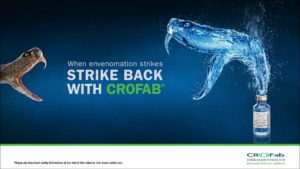The Aggressive Marketing of CroFab Continues | Another paper destined for misinterpretation
The aggressive marketing of CroFab, the snakebite antivenom, took another leap forward today with the publication of an article in Clinical Toxicology.
Early administration of Fab antivenom resulted in faster limb recovery in copperhead snake envenomation patientsThe scientific paper is an analysis of a sub-group from the large prospective trial from a couple of years ago that described no real demonstrable difference in outcome between patients that received CroFab after copperhead envenomation and those that received placebo. Despite not showing any benefit after a few weeks, the first paper was spit-shined and spun by people who should know better to suggest some value in pushing the incredibly expensive drug. Watch the same thing happen with today’s paper.
I remember attending the North American Congress of Clinical Toxicology Annual Scientific Seminar in Boston in 2015 and sat in on the luncheon (sponsored by BTG Pharmaceuticals, the maker of CroFab). I grabbed my little white box with my dry turkey sandwhich and diet Pepsi, sat down and began to listen to Charles Gerardo and Eric Lavonas (2 of the authors of the paper) explain the results of the first prospective, double-blind, placebo-controlled trial of CroFab in copperhead envenomation. Within a couple of minutes it became embarrassingly obvious that the ridiculously expensive drug had no benefit – made no difference – to any of the patients treated with it. The roomful of toxicologists and poison specialists sat in stunned silence as the authors justified the use of the antivenom because some of the patients had slightly better outcomes at 14 days post-envenomation and those benefits completely vanished at 28 days. As one of the physicians in the room mentioned during the question and answer period, “If this drug cost $100/dose, then this wouldn’t even be an issue – we would just give the drug. But as it is, each dose costs more than $4000 and we are giving multiple doses – if the drug doesn’t have really, really great benefits, our patients are adopting a medical debt that could cripple them for the rest of their lives.” The drug company’s answer to that concern was along the lines of “Well, you have to engage in shared decision making with your patient when it comes to this drug,” which caused eruptions of laughter in the room.
Regardless of the negative results of this well-designed and well-executed clinical trial, the scientific report published in Annals of Emergency Medicine in August 2017 was written in such a way so as to make the results seem more positive than they really were and suddenly every review article and podcast and professional publication was pushing the aggressive use of CroFab for copperhead envenomation.
I and my colleagues have, for the past year, tried to bring some appropriate interpretation to the conversation. I don’t believe the results of the CroFab in copperhead study justify the enormous expense of the drug. Now this new paper comes along and we have to start all over again.
The paper published today is a sub-analysis of the larger dataset. They went back and dissected (or massaged?) the data just enough to describe another difference that doesn’t matter. The authors found that the 22 subjects that received CroFab early (less than 5 hours after envenomation) had faster improvement in symptoms (17 days compared to 28 days) than the 23 subjects that received CroFab later (greater than 5 hours after envenomation). Ignored in this result is the fact that at 28 days after envenomation, there was no difference in outcome whether the subject received CroFab or not.
The Disclosure statement from this paper explains a lot: SG and SRR have received funding personally from BTG International Inc. for consulting. All authors report grant money to their respective institutions to conduct research conceived and sponsored by BTG International Inc. VEA, MRO, and EJL’s institution, Denver Health, has received grant funding from BTG International Inc. for industry-initiated research, investigator-initiated research, as well as consulting fees and for writing part of this manuscript. BTG International, Inc. did not contribute to the design or execution of this analysis.
I think this paper (and the earlier one) are examples of the aggressive marketing of CroFab and this paper is a way to sell the antivenom. Copperhead envenomation is extremely common in the Mid-Atlantic states and the Carolinas and parts of the South. Convincing doctors that CroFab is somehow useful in this generally benign snakebite would be worth a whole lot of money to BTG Pharmaceutical. Hence the aggressive marketing of CroFab continues.









































